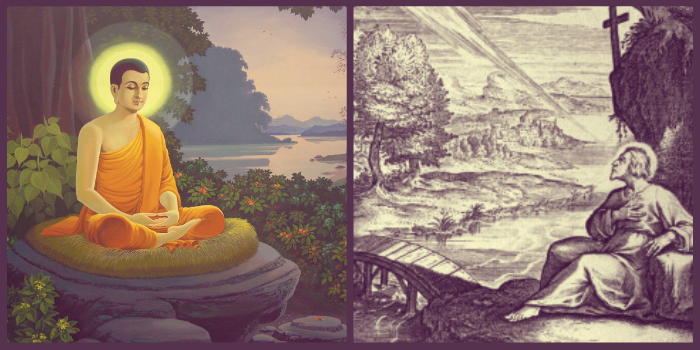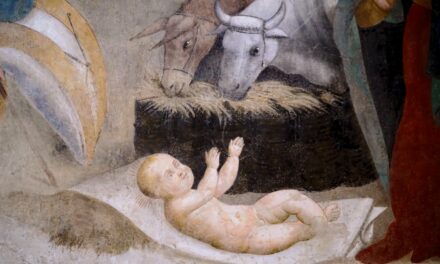 One of my friends considers herself a Buddhist Catholic so in my curiosity I took it upon myself to read more about Buddhism, something I knew little about. After some reading of Buddhism for Dummies, I discovered some interesting parallels between that tradition and Ignatian spirituality.
One of my friends considers herself a Buddhist Catholic so in my curiosity I took it upon myself to read more about Buddhism, something I knew little about. After some reading of Buddhism for Dummies, I discovered some interesting parallels between that tradition and Ignatian spirituality.
I want to point out that, explicitly, these parallels do not involve God, even though implicitly there may be a connection to a higher power. Buddhists do not believe in or worship a god. Their practice is less religion and more a spirituality of living and discovering. Therefore, it can be applied to people of various religious traditions, which is why my friend can call herself a Buddhist Catholic. In fact, the Dalai Lama encourages people not to necessarily give up their own tradition. Ignatian spirituality, while rooted in Christian tradition, can also be applied to people of different religious traditions as a way of living one’s life, seeking purpose, and finding where one fits. Its principles do not have to be exclusive to Christian believers.

The Founders’ Stories
The Buddha, or Siddhartha, as he was originally known, was born in Northern India into nobility and his father, the king, wanted him to inherit the power of the throne and he did all he could to ensure that would happen. But Siddhartha was drawn to the outside world, to discover deeper truths. After an encounter with a suffering sick person on the road he resolved to renounce his royal life to discover a way to reduce the world’s suffering.
Saint Ignatius of Loyola was also born into nobility and had a promising life of power. After a cannonball shattered his knee on the battlefield he lay in bed recovering. It was then he realised that there was more than the life paved out for him. The desire to seek the things of God reigned so he left his life of nobility and started on a pilgrimage to the Holy Land.
Ignatius and Siddhartha both exchanged their fine clothes for those of a beggar; Ignatius let his hair grow out and Siddhartha cut his (long hair was a sign of Indian royalty). Both lived for a while in self-denial and practised strict asceticism, which left them both in great weakness. After a while both came to see the extremes of their asceticism. Siddhartha found a “middle way” between this extreme self-denial and self-indulgence. This kind of middle way or “mean” is also an important part of Ignatian spirituality.
Awakening
For Saint Ignatius, his place of awakening came at the River Cardoner in Manresa, Spain. His moment of vision was a deep clarity of all creation and it shone in a new light of meaning for him. All things seemed to come together in that moment and for him it was an experience of God. It was in Manresa where he composed the Spiritual Exercises, which was likely influenced by this enlightenment at the river.
Siddhartha’s moment came underneath a fig tree, also near a river. Under the Bodhi tree, as it is known, he came to Enlightenment. It is said that “the world held its breath” in that moment. Clearly for the Buddha and for Ignatius, these were spiritual moments—though nearly two millennia apart.
Just after the Siddhartha’s enlightenment it is said that an evil demon named Mara came to tempt Siddhartha and seduce him with visions of many things of the world. Siddhartha touched the ground and said, “The earth will bear witness, to all my past action of purity.” And Mara was swept away. Ignatius during his life had many encounters with what he would call the evil spirit. In his past life he was tempted by women and prestige, but in great self-awareness Ignatius learned how to counteract such evil temptations by following the good spirit.
Freedom and Detachment
Buddhism is often characterised for its teachings on detachment. The Buddha said that the source of suffering is our attachment to things (people, objects, expectations, delusions, I don’t get what I want) and that if we can let go of such things we will find enlightenment. It means things have no power over you. Attachment comes from within, therefore suffering comes from within, as the Buddhist tradition states. Siddhartha’s renunciation of his former life and the cutting of his hair was more about detachment than about saying his former life was “bad”.
Ignatian spirituality is often characterised for its freedom. Freedom is another term for detachment. Indifference is also a word that describes what we’re talking about: not being attached to one thing or another but desiring solely the will of God. True freedom takes a lot of pressure off of us! When I find myself clinging to something—like a preferred outcome in the future, a relationship, an object—I soon discover that the clinging is the cause of my suffering, my anxiety. And that clinging originates from within. A “disordered attachment” in Ignatian language is something that I find myself clinging to in an unhealthy way, and in the Christian context, something that does not lead to me glorifying God.
 Meditation and Self-awareness
Meditation and Self-awareness
Both Buddhism and Ignatian spirituality say that prayer and meditation is necessary for any personal transformation to occur. Both traditions focus on the growing of self-awareness. Self-awareness must be gained before one can even begin to help and love others fully. As Jesus said, we must love our neighbour as ourself, but we must first use self-awareness to get to that love of self. Ignatian spirituality employs the well-known Examen prayer which lets us review the events of the day and how we reacted to various moments and what it might tell us. Ignatian discernment techniques also help us tap into our interior where attachments and desires live.
One could call self-awareness and self-learning “becoming more human”. Buddhism claims that the purpose of life is to become more human and that it can take many lifetimes to fully achieve that (enlightenment).
A Buddhist method of meditation that is helpful in self-awareness is using your imagination to place yourself in a situation that causes you suffering, say with a person you don’t like. You watch the scene unfold as an outsider. That is, you watch as a third party, what goes on between you and the other person. You watch without judgement and simply see and learn, not trying to solve or figure out. (Anthony de Mello, SJ has similar meditations in his book Sadhana). Through this observation self-awareness grows and without effort self-transformation slowly occurs.
This method is very similar to imaginative prayer in the Ignatian tradition. Often imaginative prayer involves you as a character of a Gospel scene, but it can be adapted to any situation (like described above) and you can choose to just be an observer of the scene rather than participate in it. Or perhaps you wish to see the situation from another’s eyes (like your enemy). Meditation and self-awareness, if practised regularly, have a way of reducing our destructive habits by giving us new perspective. After all, much of our suffering comes from projecting our own distorted views on things.
Mindfulness
Buddhism’s meditation techniques, like Ignatian spirituality’s, also employ mindfulness. For example, one can sit for ten or twenty minutes and simply focus on the breath coming into and out of one’s nose.
Meditation can also lead us to a mindful love and appreciation of the things around us: a butterfly, a strand of grass, our spouse, our job. Awareness like this is the root of the Ignatian principle of God in all things. There is sacredness in everything. None of these things themselves cause suffering since suffering does not originate from things but rather human attachments and unfreedoms.
The Buddha and Ignatius meant for their spiritualities to be applied to everyday life. The Buddha had promised himself that once he found the way out of suffering he would share it with others so they could practise it. Mindfulness in our daily moments gives way to profound insight. Awareness of the world’s suffering, our reactions, the reactions of others, and our brokenness, can foster greater love and ethical living—or in Ignatius’ terms, glorifying God.
Mindfulness and self-awareness: these are the main and most important parallels between the spiritualities of Ignatius and the Buddha.
Use What Works
As with methods in Ignatian spirituality, Buddhism says to use what works for you in meditation and leave the rest. Not every way is the ideal for every person. Spiritualities are deeply personal and can be applied to many religious traditions and personal needs and situations. It is important to note that spirituality is often rooted in a particular historical tradition but it flows into a personal context and becomes the context for one’s life.
Spirituality is rooted from within and reaches without. It’s no surprise that Ignatian spirituality and Buddhism have certain parallels. For ages human beings have been trying to make sense of their place in the universe and how they are to engage it. For me, God is manifested in the multitude of spiritualities lived by people around the globe. And for my friend, her Buddhist spirituality seems to merge harmoniously with her Catholic spirituality without taking away her strong Catholic identity and tradition. And like all spiritualities that offer hope for transformation, it takes practice of its methods and, most importantly, continuous reflection and awareness.
| • Anthony de Mello, SJ has stellar resources and books on the intersection of Christianity and Eastern traditions. • For a comprehensive introduction to Buddhism check out Buddhism for Dummies. • Urban Monk (meditation techniques and articles) • Catholicism and Buddhism – A lengthy article on the commonalities of Catholicism and Buddhism. |
Listen to an audio version of this post…
Music by Kevin MacLeod









Great comparison Andy. In my own faith journey I had experiences with Buddhist philosophy and meditation practices. As you indicate there is certainly some overlap between Buddhism and Ignatian Spirituality. One of my guides along the way is a friend who was a former Buddhist monk who eventually became a Jesuit priest. One of the best sources for the similarities and differences between Buddhism and Catholicism is the late William Johnston, S.J. a great mystic and author of many books, including Christian Zen.
http://brittonia.blogspot.com/2010/10/jesuit-mystic-william-johnston-passes.html
Ultimately I believe that one of the best contributions that Buddhism can make to Christianity in general and Catholicism in particular is that it can help us rediscover our own mystical traditions that unfortunately have been downplayed if not lost since the Enlightenment. In addition to the Ignatian Spirituality of St. Loyola, St. John of the Cross, St. Teresa of Avila, Meister Eckhart and author of The Cloud of Unknowing (I highly recommend the translation by William Johnston) are all wonderfully deep resources for Christians who are interested in Buddhist meditative techniques but who believe in a personal God and the Incarnation.
Thank you for another interesting, accessible and enlightening post. Thank you for following your curiosity.
This was an excellent, well researched article. I followed the Zen tradition for some ten years before coming to the Church. You have shown very clearly how Ignatian spirituality and Buddhist spirituality intersect. The key is to shed attachments, to be fully available to everyone without “looking back “, and to be able see all the world in a single grain of sand. It’s not mystical : it’s exceedingly practical. For Catholics , follow God into your deepest self, discover the unique job he has given only to you since before the beginning of time , return remade in light in love to serve freely. This is the day The Lord has made, and YOU are made for it.
Johnston’s books / translations are very good. Also , another Jesuit priest who exploded the intersection of the traditions is Fr Robert Kennedy (who is also a zen master):
http://en.m.wikipedia.org/wiki/Robert_Kennedy_(Jesuit)
“Exploded” should read “explored” !!!
Andy, Nice job on this article. Ignation spirituality can be, and has been, described as a spirituality of finding God’s will for a better decision making. Both Buddhism and Ignation spirituality say that prayer and meditation is necessary for any personal transformation to occur. I really enjoyed the post share here with good information. Very inspiring.
Such a useful post – very enjoyable and rewarding!
There are forms of Buddhism far more similar in outlook to that of the Abrahamic faiths (more emphasis on faith and devotion).
A couple of books you might find interesting in this vein might be: ‘The Wisdom of James’ by John P. Keenen (http://astore.amazon.com/bodhi.mine-20/detail/080914168X), ‘Awakening to Prayer’ by Augustine Ichiro Okumura (http://www.amazon.com/Awakening-Prayer-Augustine-Ichiro-Okumura-ebook/dp/B00BC69CJG) and/or ‘Shinran’s Conversion in the Light of Paul’s Conversion’ by S Takayama (http://www.amazon.com/Shinrans-Conversion-Light-Pauls-Gregoriana/dp/8876528628/). All of these are from Christian authors, about Christian themes examined with reference to similar themes in JodoShinshu Buddhism.
Thank you for sharing your insights into the similarities between mindfulness and the Ignation examen.